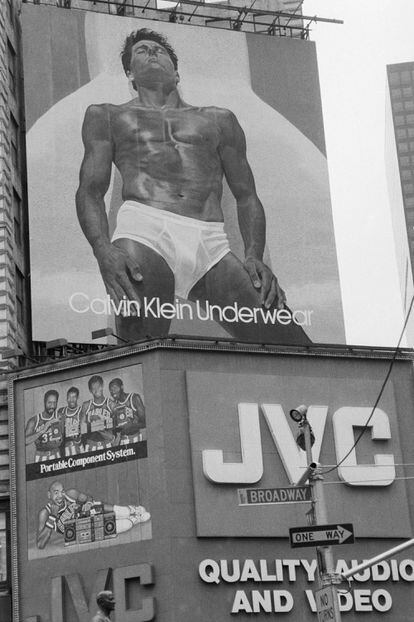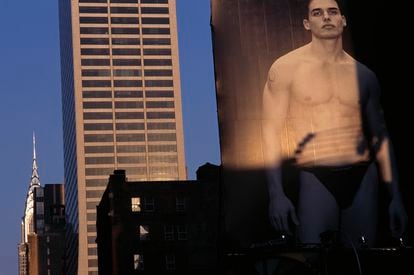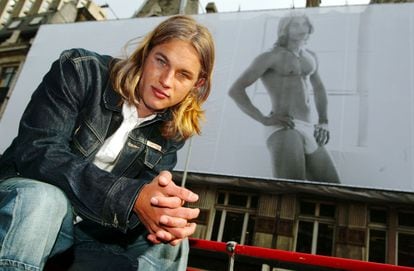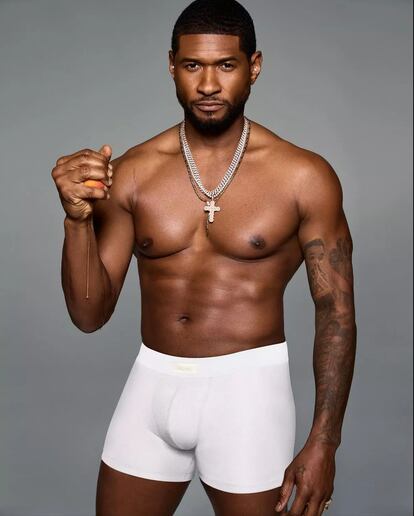“Men's underwear advertising embraces real men,” advertisement The New York Times in 2019. If it had happened, it was short-lived. In the same way that it is argued that if the catwalk models are thin it is because the dresses must have a fall, a flight and a flow that only occurs if it hangs from a body without curves or relief, it seems that underpants can only They can be seen in their full glory if they are tense under a flat, square belly and on strong legs. Furthermore, this type of advertising has been going strong for four decades. Why change it? The singer and actor Usher has just written a new episode by becoming the image of the Skims men's underwear line, owned by Kim Kardashian, at 45 years old. It's not that he looks 45, not that he intends to, judging by his abs, but the number is there: a man closer to 50 than 30 has been the last to suggest himself half-naked in his underwear.
Underpants advertisements are a source of controversy and at the same time a perpetuation of normative physiques; barometer of celebrity and indicative of the state of affairs of male beauty: it is the photo that is shown to a trainer while being told “I want to wear So”. Underpants advertisements have embraced many realities. White, black or oriental men. From canonically beautiful faces to Martian beauties. The bodies? Sometimes more muscular, other times more languid, but – through a modeling agency – never similar to what ordinary people have. Although sometimes, on special dates, they go beyond the norm. Rihanna's Fenty line has been applauded for showing models with real bodies with their line of underwear (which also include boxer shorts with lace and transparencies). Last year, Calvin Klein featured a transsexual man who had not had a mastectomy advertising bras from the brand (to the horror of the conservative press). But it was a mirage in the usual oasis of the month before Pride, in which all brands experiment with inclusivity. Masculinity, the rest of the year, generally continues to look the same.
Just a month ago, actor Jeremy Allen White (a typology of Martian beauty with a Crossfit body) demonstrated that there are classics that are always repeated, such as how a famous person running around in his underwear is still able to take over the conversation, causing traffic jams in front of the marquees and occupy the news. In his case, with rebound controversy: when an advertisement, also by Calvin Klein, starring FKA Twigs, was censored in the United Kingdom, the accusation of double standards arose: we can see a man running around naked in his underwear, but a woman , less. Or a twist: the objectification of the male body is celebrated, while, after too many decades, we begin to question that of women. In any case, the question is on the table: is men's underwear advertising experiencing a new golden age?
The aspirational aspect of a waistband
Advertising for men's underwear usually focuses on pure and simple beauty and that idea, now so familiar, called the aspirational: A rubber waistband with a recognizable brand visible above your pants is, for some, something that makes you sexy, a way to be a little less imperfect. “Undress safely on any occasion,” they say from Calvin Klein's own website if you want to buy their underwear. It's the two plus two of advertising, the simplest syllogism: if I wear the underwear that that muscular guy on the marquee is wearing, I'll look a little more like him and a little less like myself.


Calvin Klein had already hired recognizable models and athletes in the eighties, such as the Olympic jumper Tom Hintnaus, and had put them in front of legendary photographers (Bruce Weber or Richard Avedon), but it was Mark Wahlberg, then better known as Marky Mark, the that would change everything. The rapper had appeared in October 1992 on the cover of Rolling Stone wearing Calvin Klein underwear and gave the brand the idea (according to legend, to millionaire David Geffen, who was an investor) to hire him as an image. A photograph by Herb Ritts in which the model grabs his genitals did the rest.

We had seen boldness before in underwear advertisements: a Calvin Klein campaign from 1985 photographed by Bruce Weber showed two men and a woman, all in their underwear, sleeping together on a couch. The elements of the famous Wahlberg photo weren't even new: we had seen models in underwear and we had seen celebrities grabbing their genitals (it was a common part of Michael Jackson's choreography, although it was difficult to find anything sexual about it), but never all of it. together and with so much aesthetics and at the same time so much carnality. In the old underwear ads the men were muscular mannequins, but Marky Mark was an impertinent young man touching his private parts on gigantic marquees while he stared defiantly into the camera. And also, a famous young man: he had just had a number one with Good Vibrations, with his group Marky Mark and the Funky Bunch, where he also sang shirtless. In fact, Wahlberg was almost always in his underwear on stage. The complicated thing would have been to photograph him dressed.
The formula has continued to work for years, with variations and at times, trying to make the underwear less and less visible and the flesh more and more. In 1997 the model Renaud Tison He showed his butt in a Gucci Underwear ad photographed by Mario Testino. In 2001 Calvin Klein stepped forward and showed what everyone wanted to see: a huge bulge. The model and actor Travis Fimmel posed for the American brand with very small underwear that filled out in an enviable way. The image caused traffic problems in cities like London at the points where the giant poster dominated the city. In 2002, the Advertising Standards Authority (ASA, the same ones that cried foul over the FKA Twigs ad) withdrew private accusations against the brand for having made a poster that was “indecent, sexually suggestive and degrading to men.” .

The Swedish footballer Freddie Ljungberg made it fashionable in 2004 to sell football stars to sell underwear. Some underpants, as in the case of Fimmel, who also filled out in a marvelous way. The fun was no longer just seeing a celebrity in underwear, but seeing a celebrity in underwear with an endowment worthy of comment. Whether that endowment was real or not was not yet on the board (that conversation comes in the next paragraph). Dolce & Gabbana upped the ante in 2006 by portraying the Italian team in the locker room in their underwear. Armani called David Beckham in 2008. That lump was also commented on, especially because they were already beginning to be strange lumps: voluminous but without showing any recognizable silhouette.
Centimeter by centimeter
In 2015, Calvin Klein opted for the person who sparked the most conversation in the world. Justin Bieber, then 21 years old, made those advertisements that were previously admired on huge posters that simply caused traffic jams become, with social networks reigning in the debate, elements scrutinized inch by inch. It is not a word game. “How much photoshop Is there in Justin Bieber's package?” the whole world asked. And the worst thing is that someone responded: the website BreatheHeavy obtained the unretouched images (it was said that they were sent by someone who had participated in the session and editing and that, obviously, he skipped all the confidentiality clauses) and published them (he had to delete them later, after a lawsuit). The difference between before and after (in the volume of the pectorals, the arms, the butt and, yes, the genitals) showed what the world already suspected. However, the before and after of those specific photos is not as important as the before and after that marked the way in which campaigns starring celebrities in underwear are received. Shawn Mendes also posed for the brand in 2019 and he too received the exhaustive analysis: the networks ruled that his lump was very small.
It didn't happen to DJ and producer Calvin Harris in 2015, when he showed off his gym hours in a campaign for Armani. The networks ruled that his bulge was very good and no one questioned it. The jeering and mockery, apparently, was only suitable for post-adolescent singers over whom the shadow of the rumor about his sexuality hung over. Harris, a grown man with a long list of lovers, was not questioned.


Usher's campaign, at 45, marks a new direction with a model over 40 (Beckham last posed in underwear at 37 for H&M), whether that age appears or not. Furthermore, with that phrase of spot “What I like most about acting is that element of intimacy between me and my audience” is inevitably reminiscent of a controversial phrase by Brooke Shields (“Do you know what there is between me and my calvins? Nothing”), in that jeans ad (also for Calvin Klein) that he filmed when he was only 14 years old and forever marked the course of fashion advertising: a well-known and attractive face, sensual candidness, an uncomfortable element and millions of people giving their opinion in their houses. They have also done it with Usher's lump, of course. “Usher surprises his fans with a big bulge in a photo shoot for Skims,” has titled the Daily Star. The lump in question remains inhuman, unreal, impossible. What's between those underwear and reality? Nothing, it's just advertising.
You can follow ICON on Facebook, x, instagram,or subscribe here to the Newsletter.
#Lumps #controversies #abs #golden #age #underwear #ads

